INTRODUCTION
According to various Internet Statistics gathered
by several resources like Network Wizards,
the number of hosts in the Information Highway, "The Internet", grows exponentialy
every year!
Moreover, new high-bandwidth applications arise
(like "Web-TV") or will arise, imposing high "Quality of Service" demands
on ISPs (Internet Service Providers).
Therefore, current and future strong demands for
high baud (= throughput) rates per user, as Internet usage increases, require
network technology to adapt quickly to the new needs. In this project,
we are examining the factors which restrict or will restrict future required
capacity of the network.
Those restrictions are based primarily on the
bounded capability of future IP (Internet Protocol) routers, to forward
"quickly enough" incoming packets to the proper destinations, due to several
physical limitations, like finite (not zero) memory access time (needed
for searching in the routing table the proper destination port) or switch
time (needed to connect input and output ports) of the router.
We are describing the current and future "bottlenecks"
of IP routing technology and using fundamental quantum mechanics principles,
we are estimating the ultimate, best achievable, future capacity of "The
Internet"!
Bandwidth limitations are also considered. However,
they are not so critical as the routing ones, as we will prove!
BANDWIDTH LIMITATIONS
A simple question:
is bandwidth a current limiting factor on the expansion of Internet?
We can answer that question very easily:
Current available fiber point-to-point links have a capacity of Terabits/sec.
This estimation comes from the following calculations:
 
Due to physical factors, light passes easily through fiber in only three
parts of the optical spectrum. These bands are about 200 nm wide and are
centered around 3 specific wavelengths:

At these specific wavebands, the absorption of light due to impurities
in the glass core of the fiber, is minimal (at least, in large part). Using
equations (1),(2) we obtain:

Given that standard signaling equipment can signal at least 1 bit/Hz,
we can see estimate the fiber capacity in the Terabit/sec regime!
Shannon theorem, assuming a Gaussian channel, also gives the same estimate:

Modal, chromatic and material dispersion of the light pulse, impose
an upper bound on the overall fiber capacity, however we can safely assume
that Tbps rate is reachable.
However, available, commercial, state-of-the art IP routers, can
work only at Gbps rate!
So, the most serious, CURRENT, limiting factor on the expansion
of Internet is basically the routing capability of IP routers, not
bw!
Therefore, in order to understand the IP routers limitations, we will
have to discuss basic IP routing principles:
ROUTING
Basic Principles
With the term "router" we mean the layer-3 ("network layer" according
to O.S.I hierarchy) intermediate system, which is
responsible for "packet switching". Every IP packet ‘travels’ from source
endpoint to destination through a connectionless "best effort" layer-3
service. IP routers, within an autonomous network communicate with each
other through Intra-domain Gateway protocols (like Routing Internet Protocol,
Open Shortest Path Find). When they are used for connecting many autonomous
networks, they interchange information through Inter-domain Gateway protocols
(like Border Gateway Protocol).

In every case, an IP router is informed about the logical topology of
the networks within it operates and updates its routing table, which associates
every possible packet destination with one of the router ‘s physical ports.
The routing table is used in forwarding every incoming datagram (= IP packet)
to the proper output physical interface so as the packet can continue it’s
travel to the next router or final destination.
So, the router must be able to:
..."read" incoming information at the physical
layer,
...remove data link layer header (data link
decapsulation), extract the IP information,
...estimate the proper output link based on
the IP destination,
...encapsulate the new data link layer header
and
...forward the packet with the proper output
physical format!
IP Routers Architecture
A generic router follows. We have skipped every connection between
the modules, so as to provide the most general router, without sticking
to any particular architecture.
The "INPUT proc" is responsible for operations a),b), "Internet proc"
is responsible for the implementation of the routing protocols and the
estimation of the routing table, "forward proc" uses the forwarding information
from the routing table to estimate the output interface for every incoming
packet and triggers the switch fabric to forward packet to proper output
interface. "OUTPUT proc" is responsible for d),e). Queuing may be needed
at input and output interfaces either because of ‘burst’ incoming traffic
or because the router offers "class of service" packet prioritization,
therefore forwards the packets not in a FIFO manner.
Note that Internet processor is a different module than forward processor.
That is necessary, so as the timely update of the routing table does not
block the forwarding functions of the router (and as a result decrease
its efficiency).
{Some routers architecture combine separate input and
output buffers for every physical port. Others, also incorporate separate
forward table for every physical interface. In the following section, it
will be clear that our analysis is architecture independent}
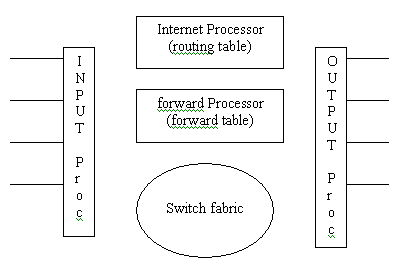
Packets are coming from several input interfaces, so the forward processor
must find the proper output physical port and trigger accordingly the intermediate
interface in order to connect input with output. That intermediate interface
which connect N input physical interfaces to N outputs, is called ‘switch
fabric’:
The switch fabric architecture differs from implementation to implementation:
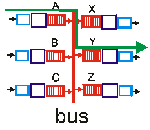
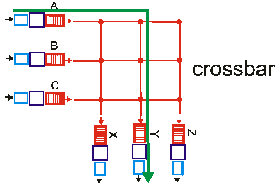
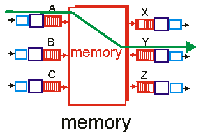
IP Addresess and Routing Table
Before analyzing the scaling problems of an IP router, we must clarify
the following:
-
IP routing is based on "longest match" IP prefixes. The routing table,
at least at backbone level, mainly contains routing information between
subnets, not between hosts. In that way, the hierarchical
organization of the Internet is being considered and the routing tables
are simplified. However, they can be quite large. The number of entries
can exceed 80,000, and the increase is related to the overall expansion
of Internet!
-
IP routers must support CIDR (Classless InterDomain Routing) addresses.
Initially, IP version 4 addresses were confined to class A (1-byte mask),
class B (2-byte mask) and class C (3-byte mask):




Because of the exponential needs for unique IP addresses and the exponential
growth of routing tables, the above Class-full scheme was replaced by the
more flexible Class-less: Class A,B,C addresses were sub-divided, allowing
for sub-division of the network which lead to smaller routing tables.

Therefore, network prefixes in Ipv4 have variable length, which can
be found if we know the ‘subnet mask’.
-
As a result, IPv4 addresses which have 4 bytes, may have a network prefix
from 8-24 bits (for CIDR the network prefix can be 29 bits long)
-
IPv6 supports 16 byte addresses, with network prefixes up to 121 bits.
Routers should be able to scale easily to IPv6 addresses.
HELPFUL QUESTIONS
Now we are ready to explore the scaling difficulties of IP gigarouters
due to physical constraints. We should be able to answer the following
questions:
-
Can the photo-detector (transformation from photons to electrons) at
input interface impose physical restrictions at the router’s forwarding
speed?
-
How quick can be a "longest match" (= therefore, searching string of
variable length) in a big routing table?
-
How quick can be the switch fabric of N inputs-outputs, knowing that
incoming packets have variable length?
FINDING PHYSICAL CONSTRAINTS
Optoelectronics
The photoelectric detector response time is proportional to  where
where  is the mobility and
L is the length of the semiconductor. So, we can fabricate photodetectors
on thin films of high mobility materials like Cadmium sulfide (CdS). is the mobility and
L is the length of the semiconductor. So, we can fabricate photodetectors
on thin films of high mobility materials like Cadmium sulfide (CdS).
There are commercially available photodetectors (InGaAs/Schottky) with
response time at the order of psecs -> Terabits = baud rate of a fiber.

from the above calculations, we can safely infer that the photodetector
cannot delay the overall forwarding capability of the router!
Memory access
As we have said, the router must make a match in a big lookup table
of a string (destination IP subnet or whole IP) which does not have a fixed
length (because subnets are described by different number of bits).
The problem of a table look-up can be addressed by several approaches:
Digital search techniques
One of the most common approaches for address table lookup is a Patricia
tree, which is a special case of a digital search tree. The idea behind
this data structure is basically a binary search tree. Depending on the
value of a particular bit in the search string, the search will take a
left or right subtree.
With some modifications, the order of complexity may be slightly reduced,
yet none of those modifications produce significant improvement from O(n),
where n is number of bits in a search string, (32,128 at most for IPv4,
IPv6 respectively). If N are the total number of entries in the table then
O(logN/log2) is the required time for lookup.
Content-addressable memory-based searches
Content-addressable memory (CAM) is a perfect solution for a really
small search space. These special-purpose chips are fast and reliable.
However, this solution is very expensive and not at all scalable, which
is why even IPv4 routers use different approaches.
Because an IPv6 address is 128 bits wide, it will further reduce the
number of entries per CAM chip. Clearly, this solution is not suitable
for the purposes of IPv6 address lookup.
-
Assumption: Let’s assume that we are clever enough, with a very
smart algorithm and a special hardware architecture to find the pair "destination
IP"- "output physical interface", in a single memory cycle (that would
be the case for fixed length string)
.GIF)
-
Current memory speeds are in the order of 20nsecs.
NOTE: We are not talking about high speed cache memory - It is an open
issue if and when Giga-Routers will incorpotate caching techniques.
1 packet/memory cycle = 1packet / 20nsecs = 50 Mpps.
That is the current routing table look up speed of the best commercially
available Giga-router.
So, if we assume that packet decapsulation, switching and encapsulation
cost zero time, then the minimum throughput of the router can be
50 Mpps * minimum internet packet length = 50 * 64 * 8 Mbps = 25,6 Gbps
!!!
note: 64 bytes are the length of an Ethernet frame!
Even though the decapsulation, switching and encapsulation of the packet
take almost zero time because of the ASIC architecture used, the routing
table lookup takes more than a memory cycle.
However, clever algorithmic and hardware approaches have reduced the
total required time for a "longest match" to:
8 memory cycles for Ipv4, 16 memory cycles for Ipv6!
The cost for that improvement, is increased memory cycles, when we want
to update the routing table:
64/72 (insertion/deletion) memory cycles for Ipv4, 352/368 memory
cycles for Ipv6!
So, for memory speed 20 nsecs:
8*20 nsec=160 nsecs => 6.25 Mpps => 6.25 * 64 * 8 = 3.2 Gbps (maximum
forwarding capacity for a "nearly" perfect table lookup!)
the insertion of a new entry in the routing table will require 64*20
nsecs=1280 nsec.
For an OC-24 = 24 * 51.84 Mbps= 1.25 Gbps) interface of a IPv4 router,
the smallest packet that can be received is Ethernet frame, (64 bytes long)
which requires
64*8/1.25 =410 nsecs.
Therefore, after the search is done, there are 410-160= 250 ns for other
tasks, such as insertion or deletion of an entry, collection of statistical
data,
and so forth.
So, for insertion, 1280/250 = 5 packet forwards (at most) are needed!
If we were able to create 1 memory cell/atom, then the memory speed
would be 1 nsec (that is the required time).
So, every number would be improved by a factor of 20 -> maximum throughput=
1 Tbps!
All the above are summarized in the following table:
|
Speed memory
|
Minimum (ideal) lookup time / packet
|
Algorithmic achievable look up time / packet (Ipv4)
|
Algorithmic achievable look up time / packet (Ipv6)
|
|
20 nsec
|
20 nsec => 50 Mpps
|
160 nsec => 6.25 Mpps
|
320 nsec => 3.125 Mpps
|
|
10 nsec
|
10 nsec => 100 Mpps
|
80 nsec => 12.5 Mpps
|
160 nsec => 6.125 Mpps
|
|
1 nsec
|
1 nsec => 1 Gpps
|
8 nsec => 125 Mpps
|
16 nsec => 61.25 Mpps
|
|
1fsec
|
1fsec=>1 Ppps
|
8 fsec => 125 Tpps!
|
16 fsec => 250 Tpps!
|
Note: the packet per sec rate can be multiplied by the current average
Internet packet length = 2000 bits, to give bits per sec rate. A better
estimate would be the multiplication with the minimum packet length, which
is 64 bytes (Ethernet packet).
Using the "Principal Uncertainty" theorem, we can estimate the quickest
memory, ever will be made, using electrons:

Therefore, the fastest memory will have an access time of 1 fsec, so
the maximum packet search will be 1packet /1fsec=1peta pps=1Ppps!
The memory requirements for the algorithmic search are 315 bytes/ route
(when compared to the 8 bytes/ route for Ipv4 or 32 bytes/route for Ipv6
with a direct memory lookup).
|
Memory requirements (bytes)
(Ipv4, Ipv6)
|
80,000 routes
|
160,000 routes
|
1 M routes
|
|
Direct search
|
0.64M , 2.56M
|
1.28M , 5.12M
|
8M, 32M
|
|
Algorithmic search
|
25.2M
|
50.4M
|
315M
|
SWITCHING BETWEEN INPUT-OUPUT
Again, the ultimate, best switching rate of the intermediate interface
using electrons, given that we have found the proper output physical interface
of the router, can be found through the principal uncertainty theorem:

Therefore, the delay at the bus from input to output will be in the
order of fsecs!
We must also notice that time is required for preprocessing(like IP
header extraction) and postprocessing (incapsulation of data link layer
header before forwarding the datagram to output port). Those operations
are handled by ASIC interfaces at current routers technologies and they
are quite fast.
CONCLUSION
The overall delay needed, due to physical constraints, for the "transit
pass" of an internet datagram through the best electronic router ever made
is in the order of several fsecs:
Overall delay: time for electron to photons + time for preprocessing
+ time for routing table look up + time for switching + time for post processing
+ time for transformation from electrons to photons = several fsecs  10-100
fsecs. 10-100
fsecs.
So the overall throughput of the best electron router will be 1/100fsecs
= 10 Tpps!
Note that we have excluded the time needed for the update of the routing
table. That was the only architecture-dependent decision we made, when
we provided the general scheme of an IP router. If the update procedure
of the routing table blocks the forwarding capability of the switch, the
above throughput rate must be divided by 5 at least, as that is the number
of packets needed for the routing table to be updated.
However, future architectures will keep separated the forwarding from
the routing table, in order to acquire the best throughput, allowing some
faulty forwarding decisions.
What about latency?
At the above analysis, we assumed that the routing table is kept updated,
in a timely manner. The routing protocols can efficiently estimate the
network topology and therefore estimate the optimal routes (through Bellman-Ford
algorithm(RIP) or Dijkstra algorithm (OSFP) ) only if the overall latency
on the Autonomous System is reasonably small. If that is not a fact, then
we are talking about a highly distributed, dynamic and stochastic system
where routing becomes problematic!
Given that we have the optimal network, with routers performing at their
limits estimated above, the latency of a datagram traveling around the
earth in a fiber, would be more than
2pi r/c=6.28*6.378 106/3*108 =12 *10-2sec
= 1.2 msec >> several fsecs, which correspond to the delay due to device
physics of intermediate systems (IS).
Therefore, the limiting factor of the expansion of Internet is, again,
the speed of light!

REFERENCES
[1] Gershenfeld N. "The Physics of Information Technology", pre-publication
notes.
[2] Perlman R. "Interconnections Second Edition: Bridges, Switches
and Internetworking Protocols", Addison Wesley, September 1999
[3] Partridge C. "Gigabit Networking", Addison Wesley, October 1993
[4] Kuhn K. "Laser Engineering", Prentice-Hall 1998
[5] Minoli D. Schmidt A. "Internet Architectures", Wiley 1998
[6] Belenkiy A. "Deterministic IP Table Lookup at Wire Speed" http://www.isoc.org/inet99/proceedings/4j/4j_2.htm#introduction
[7] Newman P. Minshall G. Lyon T. Huston L. "IP Switching and Gigabit
Routers", Ipsilon Networks
[8] "Internet Backbone Routers and Evolving Internet Design", Juniper
Networks
[9] http://www.3com.com/nsc/501302.html
[10] http://info.ewha.ac.kr/~iclab/lab/Homepage/layer3switch.html
[11] http://www.infoworld.com/cgi-bin/displayStory.pl?/features/990510mids.htm
[12] http://www.isc.org/ds/defs.html
[13] http://www.mids.org
Internet Statistics
According to MIDS the
growth in the number of Internet hosts -- computers reachable through DNS
-- which has been doubling annually for almost a decade, has slowed significantly.
In round numbers, the measured annual growth rate of the number of
Internet hosts has just dropped from 100 percent per year to 60 percent
per year.
Among its many other monitoring services, MIDS has since 1990 been analyzing
raw host survey data collected by Network Wizards
www.nw.com). For example, the number of Internet hosts increased 79 percent
per year for the 30 years between 1969 and 1999. After the deployment
of TCP/IP, the number of hosts increased 109 percent (doubled) per year
between 1985 and 1999.
But the host count growth rate is now declining. According to MIDS analysis
of Network Wizards data, the growth rate since 1996 has been 68%
per year, and since last year, 46% per year.
Roughly, hosts number currently increases by a factor of 1.6 instead
of 2 (previous years rates)!
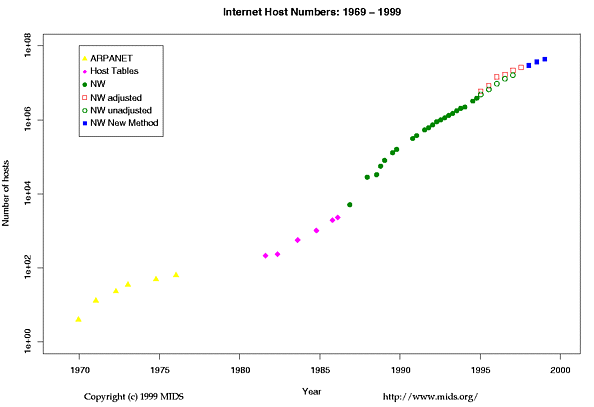
-
The number of hosts (locatable through DNS) will exceed 100 M, very soon!
for a nice applet displaying network "latency", "pinging" in Europe,
click
here!
|

